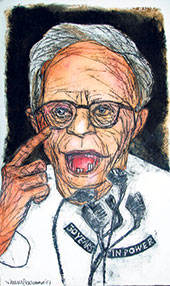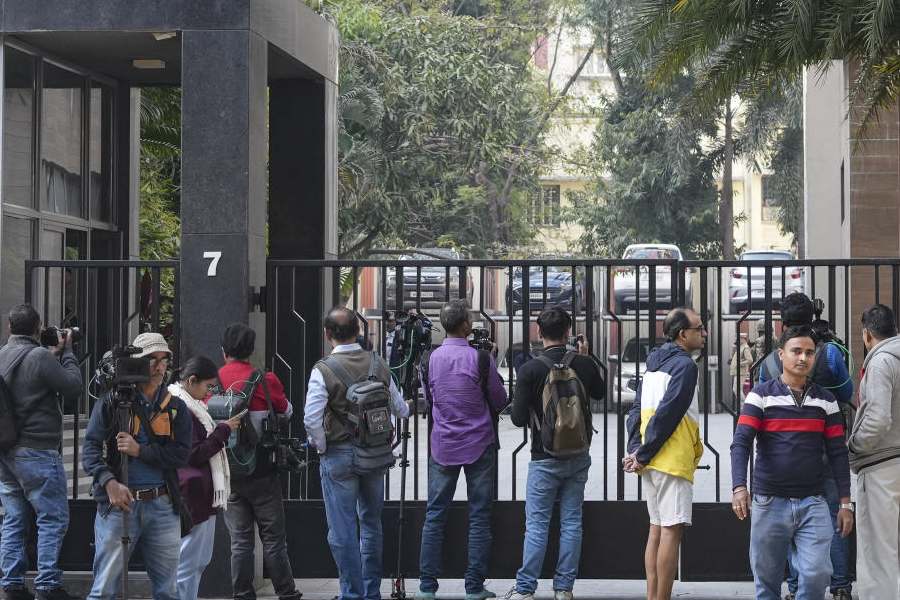 |
| Suvaprasanna’s painting titled Real Face |
Red headband circling the crop of short hair, black kurta and jeans, it’s tempting to call her Rebel without a Rifle. Some have, however, found the visit of filmmaker and actress Aparna Sen and theatre artistes Saoli Mitra and Kaushik Sen to Lalgarh incongruous, even ridiculous. Not just because they were unaware of the 144 in sway, or indifferent to the threat of Maoist landmines that gives the security forces nightmares.
“What were they thinking?” asks Malyoban Ghoshal, a sociology researcher. “Even the police have been moving hesitantly in the area for fear of landmines. And here you have the likes of Aparna Sen, Saoli Mitra and (poet) Joy Goswami making a grand entry as if landmines were designed to sniff out ‘intellectuals’,” Ghoshal says.
In the event, the landmines did stay quite out of the way. It’s not clear if Chhatradhar Mahato, the leader of Lalgarh’s people’s committee, realised his name had finally found its fulfilment in the audience with celebrities attended upon by aides holding open umbrellas.
Kaushik Sen, theatre and television artiste, explains that members of their front Swajan went driven by the need to try and open a door to negotiation between the two sides in response to appeals by Chhatradhar to “see for themselves”. Aparna Sen confirms that intention to see.
Macbeth-like, reality came banging on the door with bloodied hands with Nandigram — and to “see for themselves” became an impelling force. The artistes and writers, however, were fuelled not by creative juices but by a moral obligation.
The creative pursuit is a solitary occupation. But there have been occasions in history when writers and artistes have spoken up in protest — from Emile Zola to Rabindranath Tagore to Jean Paul Sartre to Marlon Brando. Tagore gave up his knighthood, the author and philosopher Sartre declined the Nobel Prize and Brando the Oscar.
Novelist and journalist Zola wrote, God-like, “I, Emile Zola, accuse…”, in protest against the wrongful conviction of Alfred Dreyfus, a Jewish artillery officer in the French army, for treason.
 |
| From left: Saoli Mitra, Joy Goswami, Kaushik Sen and Arpita Ghosh (far right) in Lalgarh; (below) Aparna Sen. Pictures by Amit Datta |
 |
Missing link
Such tumultuous interventions are but rare. At other times, writers, artistes and painters have said what they have wanted to say about contemporary society and man’s place in it through their work.
The debate over whether Aparna Sen and her colleagues were right or wrong in visiting Lalgarh in the middle of a police crackdown on Maoists is a point of law and order. Many who had walked in protest at the deaths in police firing in Nandigram did not make the pilgrimage to Lalgarh and have been eloquently silent. There are also those like painter Suvaprasanna who were not in the Lalgarh team because apparently they were not called.
Beyond debate is the absence from the portfolio of some of the Lalgarh lights of work reflecting current political reality, particularly before Nandigram. If the latest Lok Sabha results came as a shock to the Left and a pleasant surprise to Mamata Banerjee, the political processes that led to this dramatic change went largely unnoticed in Bengali film and theatre.
Bengal’s film and theatre enjoyed its glorious period till about the early Eighties. Is it just a coincidence that the Left Front’s reign began a few years before that in 1977? Is there a link between the decline of artistic accomplishment and the Left’s rule of over 30 years?
Historically, the creative community in Bengal has been loosely associated with the Left, though neither Satyajit Ray nor Sombhu Mitra, the greatest film and theatre personalities from Bengal, wore their political views on their sleeves. Nor was their work overtly political. But their artistic selves flourished when the Left was not in power.
When history is written, it will be known if Bengali literature followed more or less the same trajectory.
When the CPM and its allies entrenched themselves in power, artistes and writers became a part of the establishment because they were largely sympathetic to the Left. It was “their” government, from which much was expected. The honeymoon was soaked in deeper romance when land reforms followed — land to the tiller.
That with land reforms the easily hated jotdar, big landowner, died and a new power structure took hold with the party in control of nearly everything in the life of rural Bengal went unrecognised for 30 years in the work of most of those that are leading the so-called civil society movement now.
Aparna Sen has made several acclaimed films, among them 36 Chowringhee Lane, but politics has not entered her work. Ananda Lal, who heads the department of English at Jadavpur University, cites economic factors, including the producers’ priorities, dictating the content of films. “A film has to at least break even.”
There is also apparently the risk of ruffling the feathers of the bosses at Nandan, at times the only theatre that shows off-mainstream films. A recent film was apparently not allowed there for the way it looked at CPM activists.
Theatre is relatively free from these compulsions: “That connection with the box office isn’t there,” says Lal. But Bengali theatre, despite its roots in Nabanna, the Bijon Bhattacharya play that is a landmark as much as Pather Panchali is in films, has not had much to show by way of how party control has been pulling the strings of rural — and even urban to a lesser extent — life.
When urban affairs minister Ashok Bhattacharya presented to the media the list of artistes who had “received favours” from his government, the suspicion arose that their silence could be a result of selfish reasons. It is true artistes and authors have benefited from the government in terms of land or buildings. It is also true that the government is not so blind as to bless those that do not suck up to it.
High pressure
Pressure can be brought to bear in many ways. After Kaushik Sen was identified as “anti-Left Front”, the number of his group’s call-shows plummeted to four from a yearly average of 34-35.
“On one occasion, a Hooghly school cancelled our show under pressure from the local CPM MLA after making advance payment to us, which they never came back to collect,” says Sen.
There is also the issue of culture being synonymous with a shade of official red. From theatre festivals to Tagore anniversary, Writers’ Buildings selects artistes and sends out invites. It is not easy for everyone to turn down state patronage, however small.
Painter Suvaprasanna, once close to the CPM and now a Mamata acolyte, says the turning point came after Nandigram that inspired him to draw Buddhadeb as Hitler. It’s just as well he didn’t think of Stalin because it might have been mistaken as a compliment.
Playwright and actor Manoj Mitra, who is appreciative of his colleagues who went to Lalgarh, adds that it takes time for an ideology to take root, and it takes time for that ideology to crumble. “A writer doesn’t write to meet a deadline, or produce a certain kind of content,” he says as justification for the lack of “anti-establishment” plays during most of the years of Left Front rule.
Since Nandigram, plays started being more directly critical of the government. Archishman Roy, a regular playgoer, rattles off recent productions that have hit out at the ruling Left — from Poshu Khamar by Pancham Vaidik (Saoli Mitra), to Bidushak and Dakghar from Swapnasandhani (Kaushik Sen) to Agunmukho from Tritiyo Sutra, written by Bratya Basu and directed by Suman Mukhopadhyay.
Earlier, Bibhas Chakraborty had put up Mrityu na Hotya, based on Dario Fo’s Accidental Death of an Anarchist, where the protagonist is tortured to death by police, who try to pass the death off as suicide.
Against the grain
Otherwise, the Bengali stage has thrown up plays like the celebrated Winkle Twinkle by Bratya Basu in 2002, with its explicit attack on the Left. “I don’t know of anyone else doing anything similar then,” says Basu without making a virtue of modesty.
Lal, however, has a problem with plays like Winkle Twinkle, which he sees as “romanticisation of extremist Naxalite violence”. Agunmukho ends up hurling bombs, each named after a particular Bengal episode — this one for Singur, this one for Nandigram…
“This is contradictory. Violence is violence,” says Lal.
If they failed to recognise the covertly violent forces working in Bengal before Nandigram, the civil society leaders are now often accused of discriminating between violence and violence. They are charged with holding their voice when CPM members are killed by Trinamul or by Maoists and of showing no concern for Aila victims.
Kaushik Sen and theatre actor and director Arpita Ghosh admit that their schedules often prevent them from reacting in time, as in the case of Aila. Mahasveta Devi, who objects to being called an “intellectual”, says that working for the people requires a seriousness of commitment that she can see in only a few in the group.
Writer Nabarun Bhattacharya, a consistent critic of the CPM, has already written a kind of obituary of “Civil Society” in the story Susheel Samaj-e Fataru, fataru being a winged creature that can subvert any evil power structure.
“Fairy godmothering at a time when people have taken to Kalashnikovs is too little too late,” says Rimi B. Chatterjee, a novelist who teaches English at Jadavpur University.
Maitreesh Ghatak, professor of economics at the London School of Economics, sees the Lalgrah visit as an encouraging sign of civil society participating in socio-political affairs, but feels that going into a conflict zone “to see” presumes that the media is not doing its job.
The visit might have led to nothing, which the Lalgarh lights themselves admit, but Sohini Ganguly, a young schoolteacher, and her father, a retired schoolteacher, accept that it has had an impact on them. “It has been able to raise consciousness among people like us, and thus bridge the gap between village and city,” says Sohini.
What you don’t see in their works you see in their walk.











